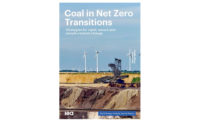The Biden-Harris Administration announced $1.5 billion under President Biden’s Inflation Reduction Act (IRA) to build and upgrade America’s national laboratories and advance American leadership in science, research, and innovation. Strengthening America’s national labs will increase economic growth; create good-paying, local jobs; and help attract skilled workers needed to drive clean energy solutions and other technologies that will lower costs for families, make people’s lives better, and address the climate crisis. In addition, the White House announced a new report that identifies five initial priorities that will help enable the U.S. to meet the President’s goal of cutting greenhouse gases (GHGs) by 50%-52% in 2030 and get to net-zero emissions by no later than 2050. To drive innovation of these technologies, the Administration is also launching the Net-Zero Game Changers Initiative today.
President Biden’s economic plan has secured transformational investments in American-made clean energy, including in wind, solar, electric vehicles, batteries, and more. Investing in these American-made solutions is critical to ensuring that the U.S. remains the world leader in clean technologies and that American workers and communities reap the historic economic opportunities and good-paying jobs that come from building a clean energy economy. America’s investments in scientific research, including through its world-class system of national labs, is core to U.S. economic competitiveness and enables innovation across the economy. Today’s funding announcements will give a long overdue boost to 13 Department of Energy (DOE) national laboratories that have been at the core of major scientific discoveries, and continue to be essential to advance America’s energy, economic, and national security.
The increased funding for the national laboratories under the IRA will support innovative research in clean technologies, including those identified by the Game Changers Initiative. These investments will help the U.S. meet its climate goals while bringing down energy costs for American families, advancing U.S. energy security, and creating good-paying jobs. For more information about new funding for national labs, click here.
Advancing the Game Changers Initiative: The Net-Zero Game Changers Initiative accelerates game-changing climate innovations helping the U.S. meet the president’s goal to reach net-zero emissions no later than 2050. To launch the initiative, the White House Climate Policy Office, Office of Science and Technology Policy, and Office of Management and Budget are jointly releasing a new report, U.S. Innovation to Meet 2050 Climate Goals, which describes 37 game-changing R&D opportunities identified across federal agencies. The priorities include opportunities for near-term wins, investments in underserved communities through the Justice40 initiative, and long-term transformation of the energy system. The administration will jump-start clean energy innovation with five near-term priorities:
- Efficient Building Heating and Cooling: Building HVAC is responsible for more than half of residential building energy use and nearly one-fifth of commercial building energy use. While buildings in the U.S. have become more efficient in recent years, most existing heating and cooling equipment is still inefficient and uses climate-warming refrigerants, which hurts consumers and contributes to climate change. Innovative technologies, such as highly efficient heat pumps and advanced refrigerants, could address many issues simultaneously. In addition to GHG reductions, the benefits of successful innovation for efficient heating and cooling include significantly reducing indoor air pollution, tripling or quadrupling energy efficiency, bolstering domestic manufacturing, supporting good paying jobs in America’s communities, promoting national and energy security, and lowering household energy bills. Further innovation — paired with the financial incentives in President Biden’s Inflation Reduction Act — will help reduce upfront costs of these appliances and make the clean option the easiest option.
- Net-Zero Aviation: Greenhouse gas emissions from air travel are expected to grow in the U.S. and around the world. At the same time, aviation — particularly long-distance travel — is one of the most difficult sectors for emissions reductions today. There are several options for cleaner aviation, including new carbon-neutral fuels, advanced biofuels, and electrification (including battery electric and fuel cell electric concepts). The U.S. public and private sectors are also exploring entirely new concepts for air travel, such as small electric vertical takeoff and landing aircraft. Innovation will make zero-emission fuels and vehicles cost-competitive with today’s aviation while reducing the aviation industry’s dependence on fossil fuels.
- Net-Zero Power Grid and Electrification: The original U.S. electricity grid was not designed for today’s requirements, including supporting widespread electrification of vehicles, new appliances, and industrial processes; deploying widespread renewables; and withstanding the impacts of climate-induced extreme weather. To ensure the availability of clean, affordable, and reliable electricity while rapidly electrifying new parts of the economy to reduce America’s dependence on fossil fuels, the planning and operations of distribution and transmission grids must be fundamentally transformed by 2050. The grid of the future must be able to sense and adapt to changing electricity demand and external factors in real time, all while the grid’s total capacity is expanded and decarbonized. Besides enabling electrification and integration of clean power sources, these innovations will also reduce the total cost of reaching net-zero emissions across the economy and increase grid resilience.
- Industrial Products and Fuels for a Net-Zero, Circular Economy: Industrial processes represent some of the most challenging obstacles to reaching net-zero by 2050. This priority area focuses on new ways to make materials and fuels that reduce GHGs, increase efficiency, and cut waste. It includes solutions for reducing GHGs and increasing efficiency of industrial process heating, material production (such as metals, cement, plastic, and chemicals), and water treatment processes. It also includes pathways for producing net-zero electrofuels — synthetic fuels made from clean electricity — that could be used as energy-dense transportation fuels. Advanced industrial processes also include the systems and technological innovations needed for energy-intensive water treatment processes, such as desalination and wastewater treatment. Producing all of these materials and fuels in a net-zero economy will require developing innovative chemistries, strengthening supply chains, and designing processes and products to deliver the same or better services for people with recycling and re-use in mind.
- Fusion Energy at Scale: Fusion, the same process that powers the sun and stars, has the potential to transform the energy system. It could provide abundant clean, reliable electricity anywhere in the U.S. or around the world, and could create a whole new industry and associated workforce. Fusion could potentially meet a large fraction of electricity demand and help eliminate GHG emissions from energy-intensive industrial processes, synthetic fuel production, and desalination. For these reasons, it could have impacts far beyond electricity generation. Because it relies on abundant, clean fuel sources, it can benefit national security and improve air quality in areas historically burdened by fossil generation.
.jpg?1669397362)



